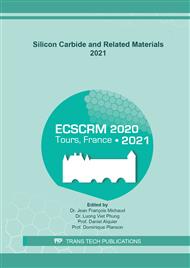p.69
p.74
p.79
p.84
p.89
p.94
p.99
p.104
p.113
Analysis of the Morphology of the Growth Interface as a Function of the Gas Phase Composition during the PVT Growth of Silicon Carbide
Abstract:
The growth conditions of 75 mm SiC crystals in the PVT process is varied by different methods while the temperature field is kept constant. The addition of graphite into the source material leads to the formation of an ordered step flow with step heights of 0.014 µm, while the addition of graphite into the source together with N2 doping changes the step kinetics on the main facet, leading to very large, bunched steps of 0.17 µm. When elemental Si was added into the source material large macro steps are formed on the whole crystal surface. While the doping induced step bunching is related to the incorporation kinetics, the large steps induced in Si-rich conditions are attributed the reduction of surface energy. With the variation of the inert gas pressure the morphology of the surface is altered, similarly. Under low pressure conditions (0.2 mbar) a fine step structure evolves, while at a high pressure (40mbar) large surface steps are formed on the whole growth interface. Large surface steps are strongly impeded in their lateral motion at defects permeating the growth interface. At these sites the formation of foreign polytypes is facilitated.
Info:
Periodical:
Pages:
89-93
Citation:
Online since:
May 2022
Keywords:
Permissions:
Share:
Citation:


